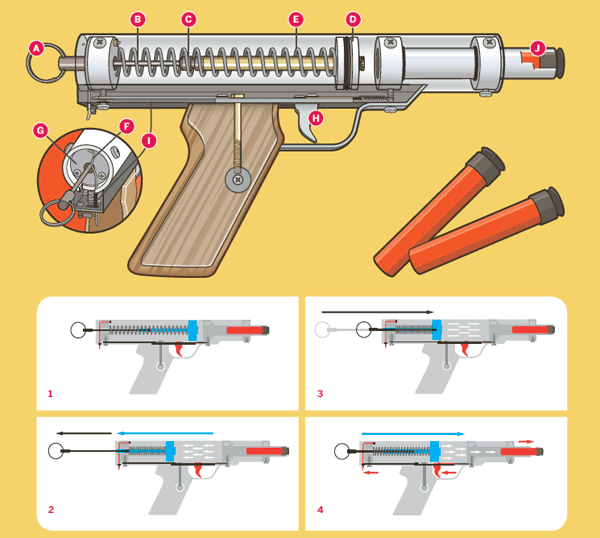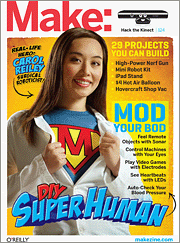
hre
There was no shortage of Nerf guns and other toy weapons in Simon Jansen’s geek-filled office, but none of them impressed Simon, so like any good maker would do, he decided to build a better Nerf gun himself. His coworker Lester had brought in the Nerf Maverick, and though he could load multiple darts, the accuracy and range left much to be desired. Simon knew one shot was all he needed if he had a superior weapon, and he was right. He shared his build instructions with us in the current issue of MAKE Volume 29, and we’ve shared the full build with you on Make: Projects. Let the games begin!
From the intro:
I made the pistol from PVC pipe, aluminum extrusion, and aluminum tubing, with wood for the grip and various pieces of metal and plastic, mostly from my junk box — and you can easily adapt the design to use what you have in yours. A sliding trigger and telescoping plunger keep the pistol short and compact. You’ll need a small metal lathe to machine some of the parts, but as there’s nothing too critical in the design, this is a nice project to hone your skills.
Here’s a breakdown of how it works:
1. To cock the gun, the user pulls back the (A) ring. This slides the telescoping plunger’s (B) inner rod back until its inner stop hits the inner rod (C) catch piece.
2. Further pulling draws the (D) piston back against the (E) compression spring, until the (F) catch wire clicks sideways into a groove in the end stop, holding the piston back in its cocked position.
3. The user may then push the ring back in, telescoping the plunger rod back with the pull ring just behind the (G) end cap.
4. Pulling the (H) trigger causes a (I) sliding plate to release the catch wire. The piston pushes forward and propels the (J) Nerf dart with air pressure squeezed from the chamber into the narrower barrel, rather than through direct spring action.
And here’s Simon showing how much his Nerf gun is better than the Maverick, by shooting a blindfolded Bender:

From the pages of MAKE Volume 29:
We have the technology (to quote The Six Million Dollar Man), but commercial tools for exploring, assisting, and augmenting our bodies really can approach a price tag of $6 million. Medical and assistive tech manufacturers must pay not just for R&D, but for expensive clinical trials, regulatory compliance, and liability — and doesn’t help with low pricing that these devices are typically paid for through insurance, rather than purchased directly. But many gadgets that restore people’s abilities or enable new “superpowers” are surprisingly easy to make, and for tiny fractions of the costs of off-the-shelf equivalents. MAKE Volume 29, the “DIY Superhuman” issue, explains how.
30 thoughts on “Build a Better Nerf Gun”
Comments are closed.
ADVERTISEMENT
Join Make: Community Today












I’ll go ahead and ask what everyone else is wondering- Where did you get that giant bender?!
Get?! I MADE him! If you Google “Beer Brewing Bender” you’ll find him I am sure.
Oh my. Wow, just wow.
hah, cool! my office is nerf firefight hell, too, and i’ve made two single shot guns so far: one based off of a crappy walmart co2 paintball gun, and one that’s basically a compressed air potato gun with a narrower barrel. the co2 one taught me that a short impulse is bad for nerf darts because it splits them open and/or squishes them against the barrel walls. the second… well, it taught me that nerf darts can leave welts as nasty as any paintball gun. heh.
any plans for an automatic? that’s what i keep turning over in my head. i am thinking of a cloth belt with a feed mechanism like a browning 1919.
Com’on, Wheres the 3D printed version :D
http://www.thingiverse.com/thing:7245
I have quite a few tools. A metal lathe is not one of them.
Hello, I was rather impressed by your custom dart blaster when I read MAKE volume 29, and I would like to point out that although it is a wonderful project, similar performance can be gained from a 10$ Nerf “Nite Finder” blaster with a simple drilling out of the air restrictor.
For homemade nerf guns, as well as modifications to existing ones, I have found the community at ‘nerfhaven’ to be an unendingly valuable resource.
careful, this gun could really scare someone if they disn’t know it shot foam bullets! also, it looks a bit heavy.
I weighed it just now out of interest. Seems to be 430g (about 15oz I think).
Awesome…although my kids love to shoot the LCD with their regular Nerf guns….wonder how would the TV screen would behave after a hit with a custom built gun…hehe….and like everyone else said…AWESOME Bender you built :)
[…] by the tame performance of a nerf pistol, you’ll appreciate this project. Hop on over to make and get all the directions to build your own badass version. I know my kids are generally underwhelmed by the distance they can get on their guns. I may have […]
No sense of style in that blaster. Most of the homemades in the Nerf Internet Community (NIC) are far more stylish, weigh less, are less complicated to manufacture, require no exotic tools, and shoot substantially farther (think 100 feet or more). It is certainly impressive, I will give him that. But it has been done better, by many people.
[…] Build a Better Nerf Gun […]
[…] Build a Better Nerf Gun (makezine.com) Share this:Like this:LikeBe the first to like this post. Makers in this post:Simon Jansen – New Zealand […]
[…] Build a Better Nerf Gun (makezine.com) […]
Fake
This is very much like the Homemades at NerfHaven. We hold nerf wars and modify guns (www.nerfhaven.com)
Because everyone has a metal lathe laying around…
[…] Build a Better NERF gun – Toys R us Nerf guns not cuttin it for ya? Make your own hot […]
[…] Build a Better Nerf Gun […]
[…] Build a Better Nerf Gun […]
[…] Build a Better Nerf Gun […]
[…] Build a Better Nerf Gun […]
[…] [Make] […]
[…] Build a Better NERF gun – Toys R us Nerf guns not cuttin it for ya? Make your own hot […]
[…] Build a Better Nerf Gun – There was no shortage of Nerf guns and other toy weapons in Simon Jansen’s geek-filled office, but none of them impressed Simon, so like any good maker would do, he decided to build a better Nerf gun himself … metal lathe to machine some of the … […]
[…] Build a Better Nerf Gun | Make: DIY Projects, How-Tos … – hah, cool! my office is nerf firefight hell, too, and i’ve made two single shot guns so far: one based off of a crappy walmart co2 paintball gun, and one that’s … […]
[…] Build a Better Nerf Gun – There was no shortage of Nerf guns and other toy weapons in Simon Jansen’s geek-filled office, but none of them impressed Simon, so like any good maker would do, he decided to build a better Nerf gun himself. His coworker Lester had brought in the Nerf … […]
[…] https://makezine.com/2012/02/15/build-a-better-nerf-gun/ […]